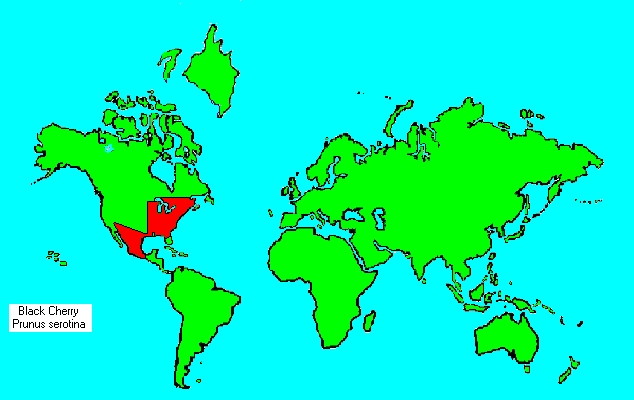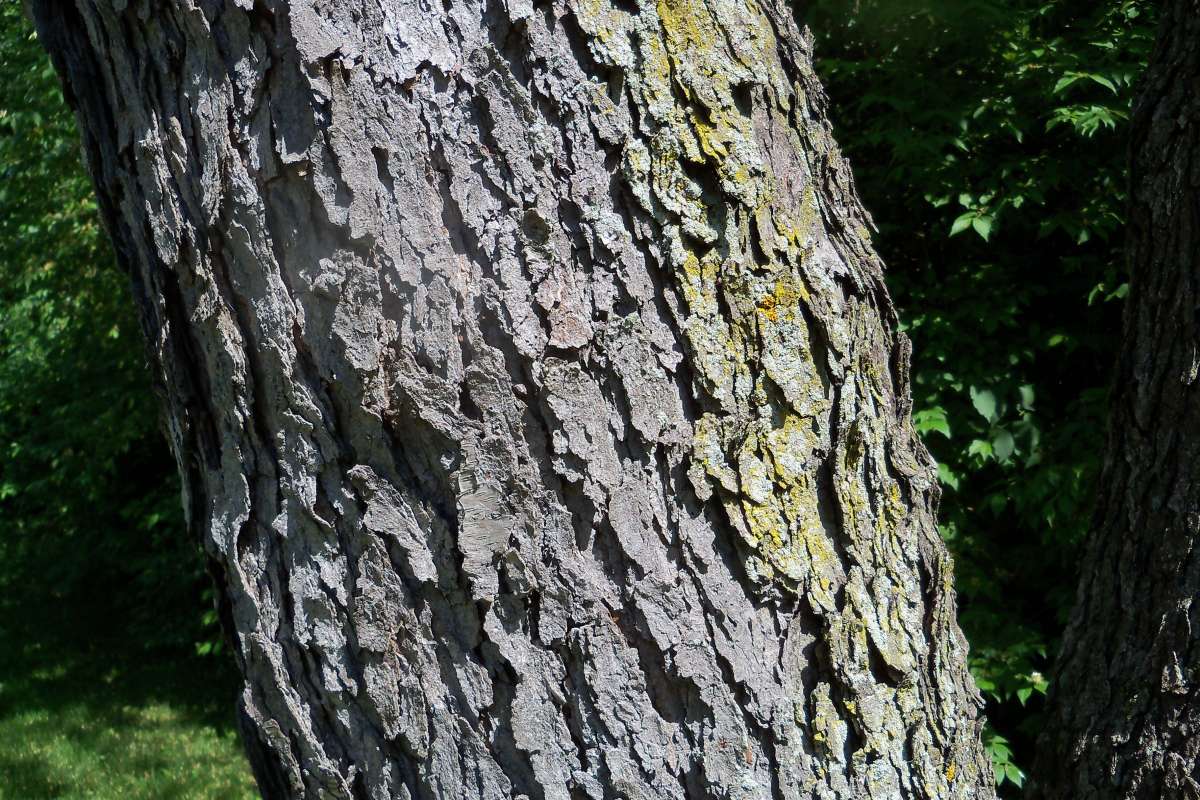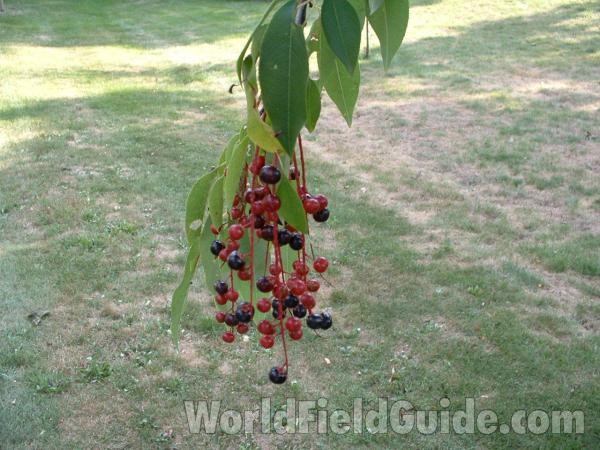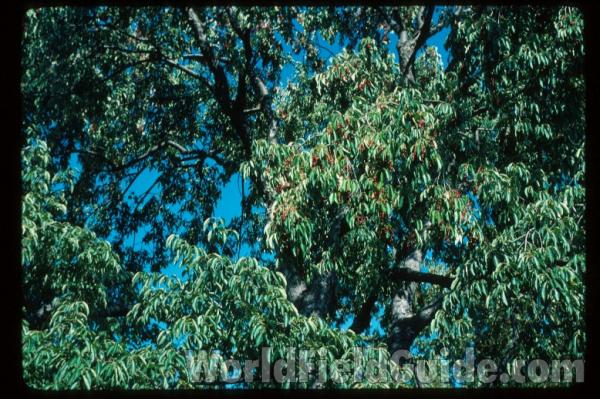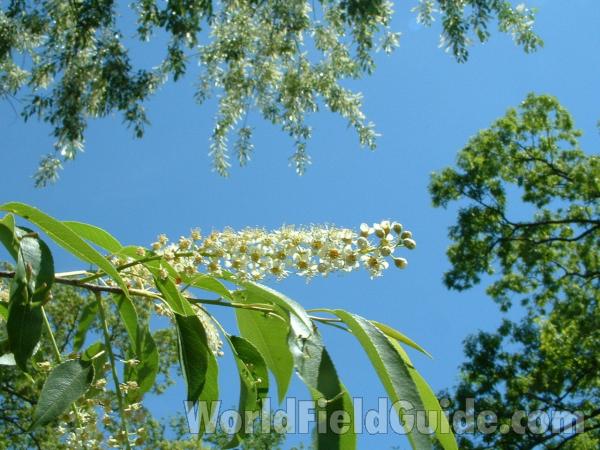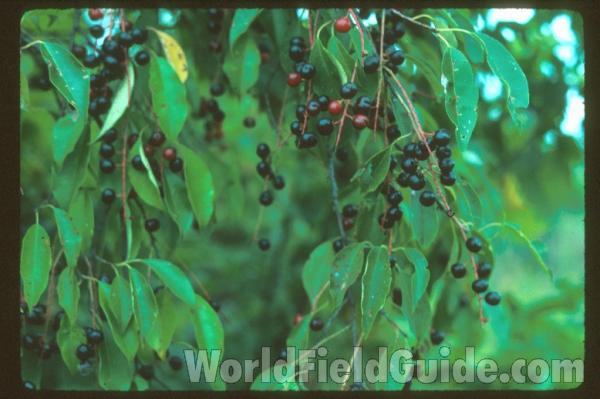SPECIES INFO
Wild Black Cherry (Prunus serotina) is found east of the Great Plains from Canada to the Gulf Coast. This is a large tree that grows to eighty feet tall. This species (Prunus serotina) and the Choke Cherry (Prunus virginiana) are similar in that the flowers are born in racemes of usually over twenty flowers and that the fruit also appears in racemes. The cherries in this species begin as red, but turn much darker as they ripen. The fruits of wild cherries contain seeds that contain hydrogen cyanide. The twigs and leaves can be poisonous.
Wild Black Cherry
In the 1913 edition of Britton and Brown these two species appeared in the genus Padus and were separated into three species:
P. nanna, the shrub, - (Newfoundland to Manitoba to Georgia
and Texas.)
P. melanocarpa - (North Dakota, Nebraska, and New Mexico)
P. virginiana, the tree, - with the narrower leaves (Nova
Scotia to Florida to Texas)
The current taxonomy appears to be as follows:
P. serotina, the tree with the narrower leaves -
(eastern half of the US)
P. virginiana, the shrub -
(most of the northern US)Prunus genus (plum, peach, and cherry trees) is a genus of commercially important fruit trees and bushes that is primarily found in the north temperate regions of the world. Additional species are also found in tropical America and tropical Asia. There are about 400 different species worldwide in this genus. North America is home to about 30 different native species. The fruits are edible in most species and the flowers are typically white or pink. There are 48 species and 31 subspecies growing in greater North America. The above counts assume that the Malus and Pyrus genera are separate from the Prunus genus. (Different authors create different boundaries for the various genera of fruit trees such as Prunus, Pyrus, and Malus. The old Padus genus has been moved into the Prunus genus.)
Prunus spinosa is a European species. Following are some of the other Eurasian species in this genus:
Prunus avium - Wild Cherry
Prunus cerasifera - Cherry Plum
Prunus laurocerasus - Common Laurel
Prunus lusitanica - Portugal Laurel
Prunus maackii - Ornamental Cherry
Prunus mahaleb - Mahaleb Cherry
Prunus padus - Bird Cherry
Prunus (Amygdalus) persica - Peach
Prunus serrula - Ornamental Cherry
Prunus serrulata - Japanese Ornamental Cherry
Prunus subhirtella - Spring Cherry
Prunus triloba - Ornamental Almond
not pictured
Sloe Plum is a European species that is sometimes found wild in the northeastern United States.
Several species in this genus contain seeds, leaves, and twigs that contain hydrogen cyanide and contain deadly poison if consumed.
The Pruneae group of fruiting trees can be identified easily because their fruit has a drupe (or stone) near the center of a fleshy exterior. The leaves are usually simple and toothed. Peaches, cherries, plums, and almonds belong here.
Rose Family (Rosaceae) of the Rose Order contains the Rose genus and is a very large diverse family containing not only the roses, but many small weeds and also the important fruit trees including the apple, cherry, pear, and plum. Along with the Grass and Legume Families, this family is one of the most important of all plant groups. There are over 3,000 species in this family organized into over 100 different genera. There are over 840 species growing in greater North America. Typical flowers in this family have five petals and five sepals.
Here the family is divided as follows:
A) Miscellaneous small wild plants such as roses, strawberries, et cetera
B) Rose hybrids of interest to the flower gardener
C) Spiraea group (which forms a natural subfamily)
D) Fruit trees and hawthorns, etceteras (Further redivided)
Crataegeae (Crataegus, Cotoneaster)
Pruneae (Cherries, Plums, Peaches)
Malea (Apples, Pears, Mountain Ash)
Rose Group (Order Rosales) contains many large and very important families. Included here are fruit trees in the family Rosaceae, the nitrogen fixing plants like clover and alfalfa (in the family Leguminosae), and a large assemblage of plants divided into over fifteen different families.
There has been considerable research in recent years as to the organization of the various plant families into orders. Although we certainly recognize and applaud those who are rearranging the families, we are staying with a more traditional approach for several reasons:
1) The traditional approach is well known, and still exists in many very popular field guides.
2) There are questions as to whether the new organizations are finalized.
3) We recognize there are essentially two different modern systems today: A European one and a North American one.
4) Furthermore, we recognize that most plant families and their boundaries are unchanged. In fact many excellent modern books present the families within the Monocots in a simple alphabetical sequence and the families within the Dicots in a simple alphabetical sequence.
Dicots (Dicotyledoneae Class) are the predominant group of vascular plants on earth. With the exception of the grasses (Monocots) and the Conifers (Gymnosperms), most of the larger plants that one encounters are Dicots. Dicots are characterized by having a seed with two outer shell coverings.
Some of the more primitive Dicots are the typical hardwood trees (oaks, birches, hickories, etc). The more advanced Dicots include many of the Composite (Aster) Family flowers like the Dandelion, Aster, Thistles, and Sunflowers. Although many Monocots reach a very high degree of specialization, most botanists feel that the Dicots represent the most advanced group of plants.
Seed plants (Phylum Embryophyta) are generally grouped into one large phylum containing three major classes: the Gymnosperms, the Monocots, and the Dicots. (Some scientists separate the Gymnosperms into a separate phylum and refer to the remaining plants as flowering plants or Angiospermae.)
For North American counts of the number of species in each genus and family, the primary reference has been John T. Kartesz, author of A Synonymized Checklist of the Vascular Flora of the United States, Canada, and Greenland (1994). The geographical scope of his lists include, as part of greater North America, Hawaii, Alaska, Greenland, Puerto Rico, and the Virgin Islands.
Kartesz lists 21,757 species of vascular plants comprising the ferns, gymnosperms and flowering plants as being found in greater North America (including Alaska, Hawaii, Greenland, Puerto Rico and the Virgin Islands.
There are estimates within the scientific world that about half of the listed North American seed plants were originally native with the balance being comprised of Eurasian and tropical plants that have become established.
Plant kingdom contains a large variety of different organisms including mosses, ferns, and seed plants. Most plants manufacture their energy from sunlight and water. Identification of many species is difficult in that most individual plants have characteristics that have variables based on soil moisture, soil chemistry, and sunlight.
Because of the difficulty in learning and identifying different plant groups, specialists have emerged that study only a limited group of plants. These specialists revise the taxonomy and give us detailed descriptions and ranges of the various species. Their results are published in technical journals and written with highly specialized words that apply to a specific group.
On the other hand, there are the nature publishers. These people and companies undertake the challenging task of trying to provide easy to use pictures and descriptions to identify those species.
